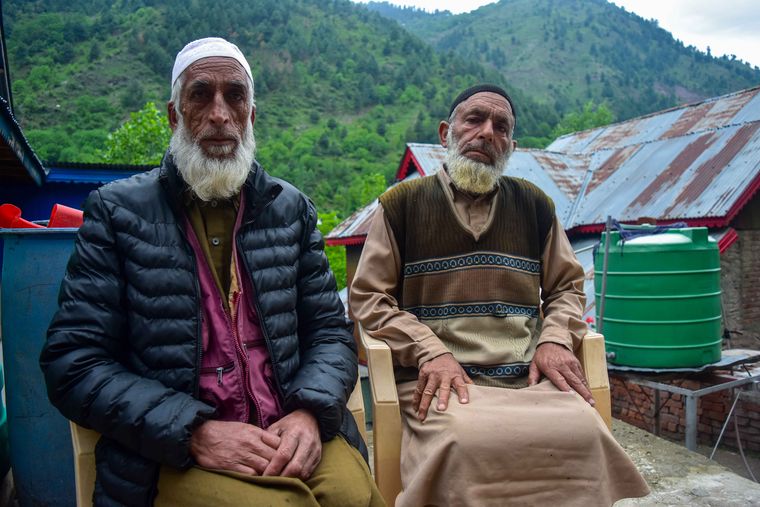URI
In the fragile terrain of the Line of Control (LoC), violence has returned with terrifying force. Retaliatory strikes by India have reignited old anxieties in Kashmir’s border villages.
As India hit nine terror sites across Pakistan and Pakistan-occupied Kashmir (PoK), Pakistan resorted to heavy shelling that killed nine civilians in Poonch. Among those killed were 10-year-old Muhammad Zain Khan and his 12-year-old sister Zoya Khan―two young lives symbolising the enormous cost civilians pay for living close to the border. The shelling was the most intense in many years, leaving homes damaged, with pieces of artillery and mortars strewn around.
Thirteen people, including four children, two women and a soldier, were killed amid shelling from Pakistan in the wee hours of May 7. Fifty others were injured across Poonch and Rajouri in Jammu and in Kashmir’s Uri in Baramulla and Tangdhar in Kupwara.

In villages like Balkote and Silkote in north Kashmir’s Uri, fear had gripped residents ever since India vowed to avenge the Pahalgam attack. Amid shelling from Pakistani posts overlooking the villages, residents have been spending sleepless nights in their homes, which bear the scars of past attacks.
Standing outside her damaged home in Balkote, Bisma Farooq, 11, recounted a recent terrifying night. “When the firing started, we were all inside, including my parents and siblings,” she said. “We don’t have a bunker. We just sat together, praying it wouldn’t hit our home.” Speaking with the calm of someone much older, she said the shelling started around midnight and didn’t stop until almost 3am. “None of us could sleep,” she said.
Balkote sits between an anti-infiltration fence―made of barbed wire, with sensors and adequate lighting―and the LoC. Many residents have now relocated to other parts of Uri. With over a lakh people, Uri is situated along the banks of the river Jhelum, which flows into PoK. It consists of 95 villages nestled among mountains that extend into PoK.
Farooq’s neighbour Muhammad Yaqoob, a former Army porter, lives with the consequences of earlier shelling. “A mortar hit me while I was working, injuring my head and hand. Since then, I can’t hear properly, and my vision is blurred,” he said. “Back then, there was tension, but what we are seeing now is worse. Ever since the Pahalgam attack, this village hasn’t known peace.”
Muhammad Sidiq, also a resident of Balkote, pointed to a pine-covered ridge across the border. “There is a Pakistani post up there. It is so high they can see the entire village,” he said. “For every 10 shells fired at Indian Army posts, five land here. The rest hit our homes. We are sitting ducks.”
The village lacks government-built community bunkers meant for civilian safety in border areas. “We have no escape route,” said Sidiq. “Our children are terrified. Our elders are helpless.” As dusk falls, fear rises. Villagers glance anxiously at the ridges, waiting for the next thump of artillery.
Amid the dread, a flicker of hope endures. “I want to become an IAS officer,” said Bisma Farooq.
In Uri’s main market, the nervousness was palpable. “What happened in Pahalgam is condemnable. We don’t support such acts,” said Atta-ullah Khan, a retired educationist, while sipping tea at a restaurant. “In 1998–1999, we suffered heavy shelling. Many died. Others lost limbs. Today, most people still don’t have bunkers.”
The aftershocks of the Pahalgam attack have rippled far beyond Uri. In Kupwara district’s Teetwal, 167km from Srinagar, the attack disrupted pilgrimages to the recently revived Sharda Temple, located on the banks of the Kishenganga river separating Teetwal from Chilhana in PoK. “After the news broke, all devotees cut their visits short and left,” said Waseen Baba, a resident.
Dating back to the 8th century, Sharda Peeth was once a global centre of learning, hosting over 5,000 scholars from Greece, Mesopotamia, Tibet and China. Originally Buddhist, it later became a Hindu site revered in Kashmir Shaivism, even under Muslim rule in the 13th and 14th centuries. The Teetwal temple, which served as a base camp for Sharda Peeth pilgrims, was reopened in 2022, sparking local tourism. “Before the attack, we were getting over a hundred calls a day,” said Ajaz Ahmed Khan of the Save Sharda Committee. “Last year, we had 10,000 pilgrims. This year, we were expecting over 30,000.” In neighbouring Tangdhar, several shops and houses were destroyed in Pakistani shelling following Operation Sindoor.
In Jammu’s border belts of Arnia and Abdullian, the situation was equally tense. After India vowed to retaliate against the Pahalgam attack, residents began clearing and stocking community bunkers that can hold over 50 people. These include separate areas for men and women and are fitted with ventilation systems.
Many villagers like Sushma Singh of Abdullian have harvested their crops early. “After the Pahalgam attack we didn’t want to take any chances,” she said. “Everyone is going about their chores, but all of us know something worse could happen anytime.”
During cross-border firing, families retreat into basements converted into makeshift shelters. Since the Pahalgam attack, small arms fire between the Border Security Force and Pakistani Rangers has become more frequent. With India’s retaliation, the ceasefire now teeters towards collapse.
Also Read
- How India planned Operation Sindoor
- Seizing the narrative
- How India pulled off the stand-off strike mission
- Operation Sindoor a success; but would a prolonged war prove detrimental?
- Pakistan army chief seems to have limited options: Anju Gupta, strategic affairs expert
- How the Army, Navy and Air Force combined to make Operation Sindoor a success
Schools across five border districts―Jammu, Samba, Kathua, Rajouri and Poonch―were ordered shut. “It was not safe,” a district official said. “Children were missing classes out of fear and were exposed to grave danger.” The intervening night of May 3 and May 4 proved particularly volatile, with Pakistani troops engaging in small arms fire across multiple sectors, including Kupwara, Baramulla, Poonch, Rajouri, Mendhar, Nowshera, Sunderbani and Akhnoor. Indian troops responded with illumination rounds to detect potential infiltration.
Local administration has now deployed emergency teams to evacuate residents from villages within a 5km radius of the international border. Relief camps have been set up at several places, including at the Government Higher Secondary School in Jammu’s Bishnah and four other sites in the Arnia sector, where around 10,000 people have taken shelter. Similar facilities have been arranged in the Madreen and Hiranagar blocks of Kathua district. In Poonch, many families fled on their own during the night as shelling continued. Casualties have been reported from Mankote village, where resident Mohammad Rafiq described spending a terrifying night amid firing before moving his family of six to safety at dawn.
As the threat of escalation looms large, some border residents like Yaqoob remain rooted in their land, hoping for normalcy to return. “We didn’t choose to live on the border,” he said, gazing at the pockmarked hills. “But we have chosen to stay.”


